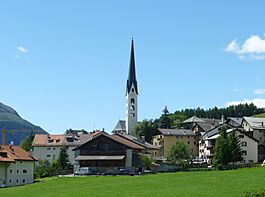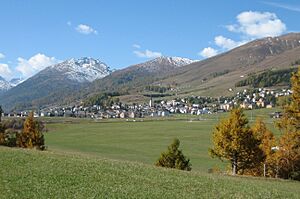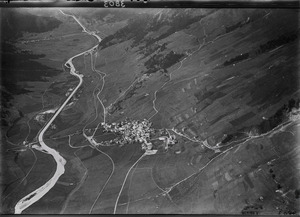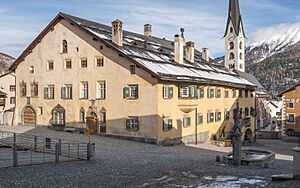Zuoz facts for kids
Quick facts for kids
Zuoz
|
||
|---|---|---|
 |
||
|
||
| Country | Switzerland | |
| Canton | Graubünden | |
| District | Maloja | |
| Area | ||
| • Total | 65.79 km2 (25.40 sq mi) | |
| Elevation | 1,716 m (5,630 ft) | |
| Population
(Dec 2020 )
|
||
| • Total | 1,199 | |
| • Density | 18.225/km2 (47.202/sq mi) | |
| Postal code |
7524
|
|
| Surrounded by | Bergün/Bravuogn, La Punt Chamues-ch, Livigno (IT-SO), Madulain, Pontresina, S-chanf | |
Zuoz (Romansh pronunciation: [tsuə̯ts]) is a charming town, also known as a municipality, located in the Maloja Region of Switzerland. It is part of the Graubünden canton, which is like a state in Switzerland.
Contents
A Look at Zuoz's Past
Early History of Zuoz
Zuoz was first mentioned around the year 840. For a long time, it was the most important political center in the upper Engadin valley. It was even the home of the local bishop, a high-ranking church leader. However, over time, other villages like St. Moritz and Samedan became more important.
Changes in Power and Independence
Between 1137 and 1139, the Bishop of Chur bought the village from a count. In 1244, a bishop named Volkart chose Andreas Planta from Zuoz to be the chancellor of the Oberengadin. A chancellor is like a chief secretary or administrator. The Planta family stayed in power until 1798.
In 1367, Zuoz joined the League of God's House. This was a group of communities that came together to protect their rights. Thomas Planta, a leader called an Amtmann (like a local governor), led Zuoz in this league.
Conflicts and New Beginnings
Zuoz and Samedan often argued. Because of these arguments, in 1438, the local court was split into two parts. In 1492, the village bought the bishop's land and his right to collect taxes in Zuoz. Later, in 1526, the bishop lost his power to judge serious crimes.
During the Swabian War, the people of Zuoz bravely burned their own fields. This was to make the enemy retreat because they couldn't find food. In the 15th century, several villages that were once part of Zuoz became independent. These included S-chanf in 1518, La Punt Chamues-ch in 1528, and Madulain in 1534. In 1554, Zuoz joined the Protestant Reformation, changing its main religion.
A Golden Age and Later Challenges
In 1512, a group called the Three Leagues took control of the Valtellina valley. This brought better trade routes and more money to the Engadin valley, leading to a "golden age" for Zuoz. During this time:
- A Latin school was started.
- The first written Romansh language was developed.
- Choir singing became popular in both religious and everyday performances.
- Students from Zuoz went to schools in other countries.
After a difficult period from 1618 to 1639, many people from Zuoz left to find work elsewhere. Losing control of the Valtellina valley also led to more people leaving and Zuoz losing its political power. When the Helvetic Republic was created in 1798, Zuoz lost all its special rights and power. It became a simple farming village.
Zuoz still keeps alive old traditions from long ago, even before Christianity. These include San Gian and Chalandamarz.
Zuoz's Landscape and Surroundings
Zuoz covers an area of about 65.6 square kilometers (25.3 square miles). A large part of this land, almost half, is used for farming. About 9% is covered by forests. Only a small part, about 1%, has buildings or roads. The rest of the land, about 40%, is made up of natural features like rivers, glaciers, or mountains.
The main part of the village is built on the side of a mountain called Munt Albanas. New buildings have grown up around this old center.
Who Lives in Zuoz?
Population and Diversity
Zuoz has a population of 1,199. About 37% of the people living in Zuoz are from other countries. In the last ten years, the total number of people living here has gone down a little bit.
Age Groups in Zuoz
Looking at the population in 2000:
- About 9.4% were children aged 0 to 9 years old.
- Teenagers aged 10 to 19 made up about 24.3% of the population.
- Adults aged 20 to 59 made up about 49.6% of the population.
- People aged 60 and older made up about 16.5% of the population.
Work and Education
Zuoz has a low unemployment rate, meaning most people who want to work can find jobs.
- About 40 people work in the primary economic sector, which includes farming.
- Around 116 people work in the secondary sector, like manufacturing or construction.
- The largest number, 462 people, work in the tertiary sector, which includes services like tourism and shops.
Many adults in Zuoz, about 72.5%, have completed higher education, either at a university or a specialized college.
Languages Spoken in Zuoz
Most people in Zuoz speak German. Romansh is the second most common language, and Italian is the third. For a long time, until the 1800s, almost everyone in Zuoz spoke a Romansh dialect called Puter. But as trade with other areas grew, more people started speaking German. In 1880, about 85% spoke Romansh as their first language. By 1941, this number had dropped to 56%.
| Languages | Census 1980 | Census 1990 | Census 2000 | |||
|---|---|---|---|---|---|---|
| Number | Percent | Number | Percent | Number | Percent | |
| German | 457 | 38.53% | 547 | 45.62% | 720 | 53.22% |
| Romansh | 461 | 38.87% | 407 | 33.94% | 349 | 25.79% |
| Italian | 183 | 15.43% | 144 | 12.01% | 133 | 9.83% |
| Population | 1186 | 100% | 1199 | 100% | 1353 | 100% |
Learning in Zuoz
Zuoz has a public school system called Scoula Zuoz. It has two main buildings:
- Scoula Primara Zuoz is for primary school students.
- Scoula da La Plaiv has classes for secondary school students.
There is also a private school in Zuoz called Lyceum Alpinum Zuoz. It's a preparatory school that gets many students from other countries.
Fun and Tourism in Zuoz
Zuoz is a great example of a traditional Engadin village. It has charming cobblestone streets and many old, historic buildings.
Winter Activities
In winter, Zuoz offers a family-friendly ski resort. You can enjoy skiing with chairlifts and T-bar lifts. There's also a center for cross-country skiing.
Summer Activities
When summer comes, Zuoz has a golf course where you can play. There are also many hiking trails to explore the beautiful mountains and nature.
Places to Stay and See
Zuoz has several hotels, including the Posthotel Engadina and Hotel Castell. Hotel Castell is a fancy 5-star hotel with restaurants, a sauna, and an outdoor mountain pool.
Zuoz is also home to one of the first bridges made of reinforced concrete, built in 1901 by a famous engineer named Robert Maillart.
Two important historical buildings in Zuoz are the Chaplutta S. Bastiaun and Chasa Pult. They are recognized as important Swiss heritage sites.
Getting Around Zuoz
Zuoz has its own railway station. You can catch trains from here to places like St. Moritz, Landquart, Scuol-Tarasp, and Pontresina.
See also
 In Spanish: Zuoz para niños
In Spanish: Zuoz para niños








